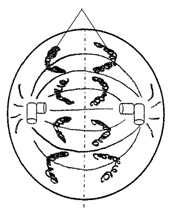Animal Cell Mitosis
|
|
A cell’s life begins when a parent cell divides into 2 daughter cells, continues as the cell grows and matures, and ends when the cell divides. This is known as the cell cycle. |
INTERPHASE
When cells are not actively dividing, they are in interphase. A cell may spend up to 95% of its life in interphase. At this time, the DNA is in a loose, soupy form known as chromatin. The chromatin contains the animal’s chromosomes. Chromosomes are long strands of DNA where genes (instructions for specific traits and proteins) are encoded. Interphase can be divided into three periods; the G1 Period, S Period, and G2 Period.
- During the G1 (Gap 1) Period the cell increases in size to adult cell size.
- During the S (Synthesis) Period, DNA replication takes place.
- During the G2 (Gap 2) Period, mitochondria and other cellular organelles replicate. Also, the chromosomes begin to coil and condense.
Parts of a replicated chromosome include…
- Sister chromatids – the identical strands of DNA
- Centromere – structure that holds the sister chromatids together
- Kinetochore – structures that develop on the sides of a centromere during late prophase. The spindle fibers attach at this point of the chromosome.
|
Animal cell in Interphase
|
Please label the
following: A. Centriole B. Centrosome C. Chromatin D. Nuclear envelope E. Nucleolus F.
Nucleus |
|
|
|
Please label the
following: A. Centromere B. Kinetochore C. Spindle fibers D. Sister chromatids
|
MITOSIS
Mitosis refers to division of the nucleus, normally accompanied by the
division of the rest of the cell called cytokinesis. Mitosis is divided into four phases; prophase, metaphase, anaphase, and telophase. Mitosis results in the production of identical daughter cells. We use mitosis when we are growing and repairing tissues.
PROPHASE
During prophase, the following events take place:
- The centrosomes replicate and then migrate to opposite poles of the nucleus. Spindle fibers stretch out between them as they move, forming a football-shaped spindle between the centrosomes.
- Microtubules radiate outward from the centrosomes to form asters. The asters will push the poles of the cell away from each other during late anaphase and telophase.
- The nuclear chromatin condenses into visible chromosomes.
- The nucleolus gradually disappears.
- The nuclear membrane completely fragments.
- Some spindle fibers grow from the poles to the center of the cell and attach to the chromsomes at the kinetochores.
|
Animal cell in prophase
|
Please label the
following: A. Aster B. Centromere C. Centrosome D. Chromosome E. Sister Chromatids F. Spindle |
|
METAPHASE
During metaphase, the following events take place:
1. The spindle fibers pull the chromosomes to the center of the cell.
2. The chromosomes are lined up along an invisible circular plate, perpendicular to the axis of the spindle, called the equator.
|
Animal cell in metaphase
|
Please label the
following: A. Equator B. Poles |
|
ANAPHASE
During anaphase, the following events take place:
- The centrosomes begin reeling in their spindle fibers.
- The centromeres break, allowing the sister chromatids to separate and be dragged toward opposite poles.
- The sister chromatids, once separated, are known as daughter chromosomes.
- The aster bodies begin pushing the poles of the cell further apart.
|
Animal cell in anaphase
|
Please label the
following: A. Daughter chromosomes |
|
TELOPHASE
During telophase, the following events take place:
- The daughter chromosomes reach opposite poles.
- The spindle begins to break down.
- The chromosomes begin to uncoil and become chromatin once again.
- Nuclear envelopes form around the two newly formed nuclei.
- Nucleoli reform
CYTOKINESIS
Cytokinesis is the process whereby the cytoplasm of a single eukaryotic cell is divided to form two daughter cells. This process results in a cleavage furrow appearing. The cleavage furrow contracts, “cutting” the parent cell into two, identical daughter cells.
|
Animal cell in telophase
|
Please label the
following: A. Cleavage furrow |
|
Mitosis Review
Looking at the pictures below and to the right, please identify which phase of mitosis each cell is in.
|
____ Interphase ____ Prophase ____ Metaphase ____ Anaphase ____ Telophase |
|
Below are descriptions of some of the events that occur during mitosis. Please indicate which phase the events take place by recording…
|
|
|
|
|
|
____ Daughter chromosomes are dragged toward opposite poles of the cell.
____ The spindle fibers drag the chromosomes to align at the cell’s equator.
____ This phase occurs immediately before cytokinesis.
____ A cell may spend up to 95% of its life in during this phase.
____ The aster bodies begin pushing the poles of the cell away from each other.
____ Spindle fibers attach to the chromosomes via their kinetochores.
____ The cleavage furrow develops.
____ The chromosomes’ centromeres break.
____ DNA replication takes place.
____ The chromatin will condense into chromosomes that are visible.
____ The daughter chromosomes reach opposite poles of the cell.
____ The spindle forms.
Mitosis Review
Looking at the diagrams below, please identify which phase of mitosis each cell is in and label any indicated structures.
|
Phase: ____________________________
|
Phase: ____________________________
|
|
Phase: ____________________________
|
Phase: ____________________________
|
|
Phase: ____________________________
|
|


















